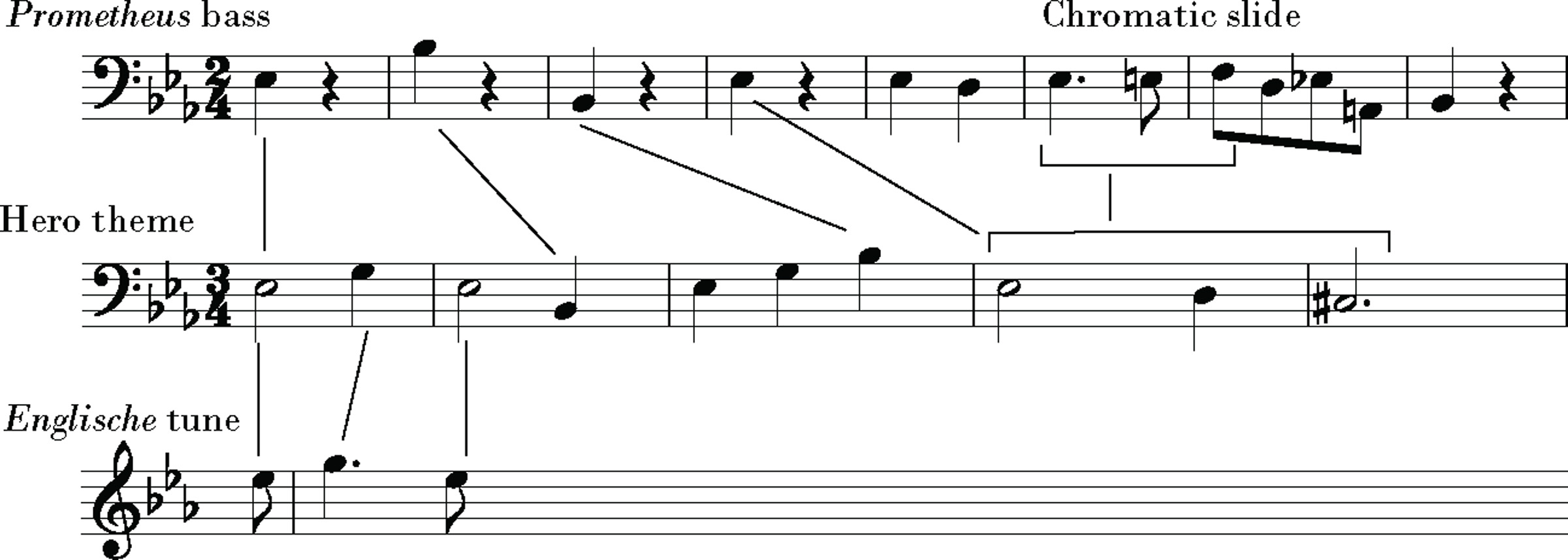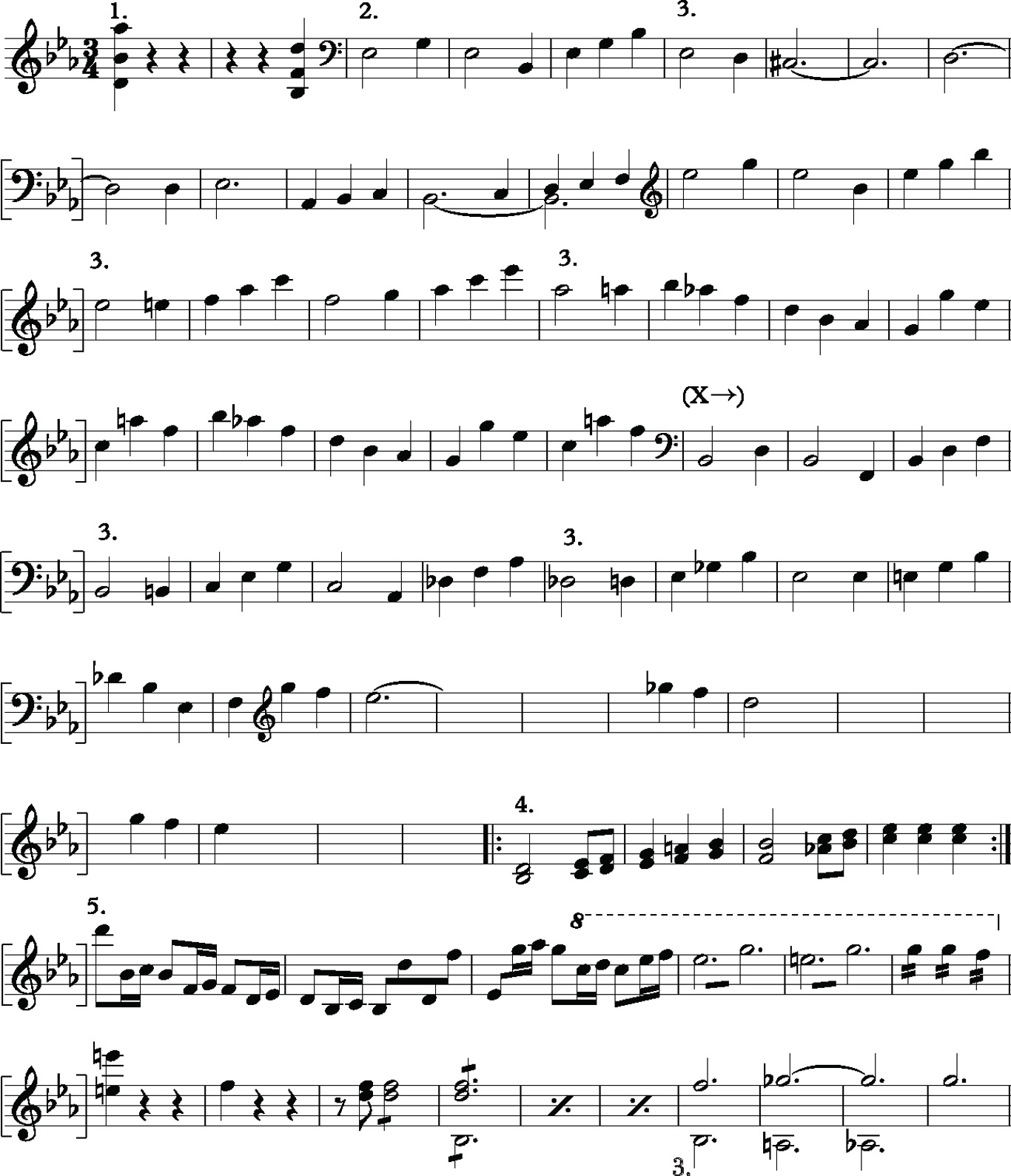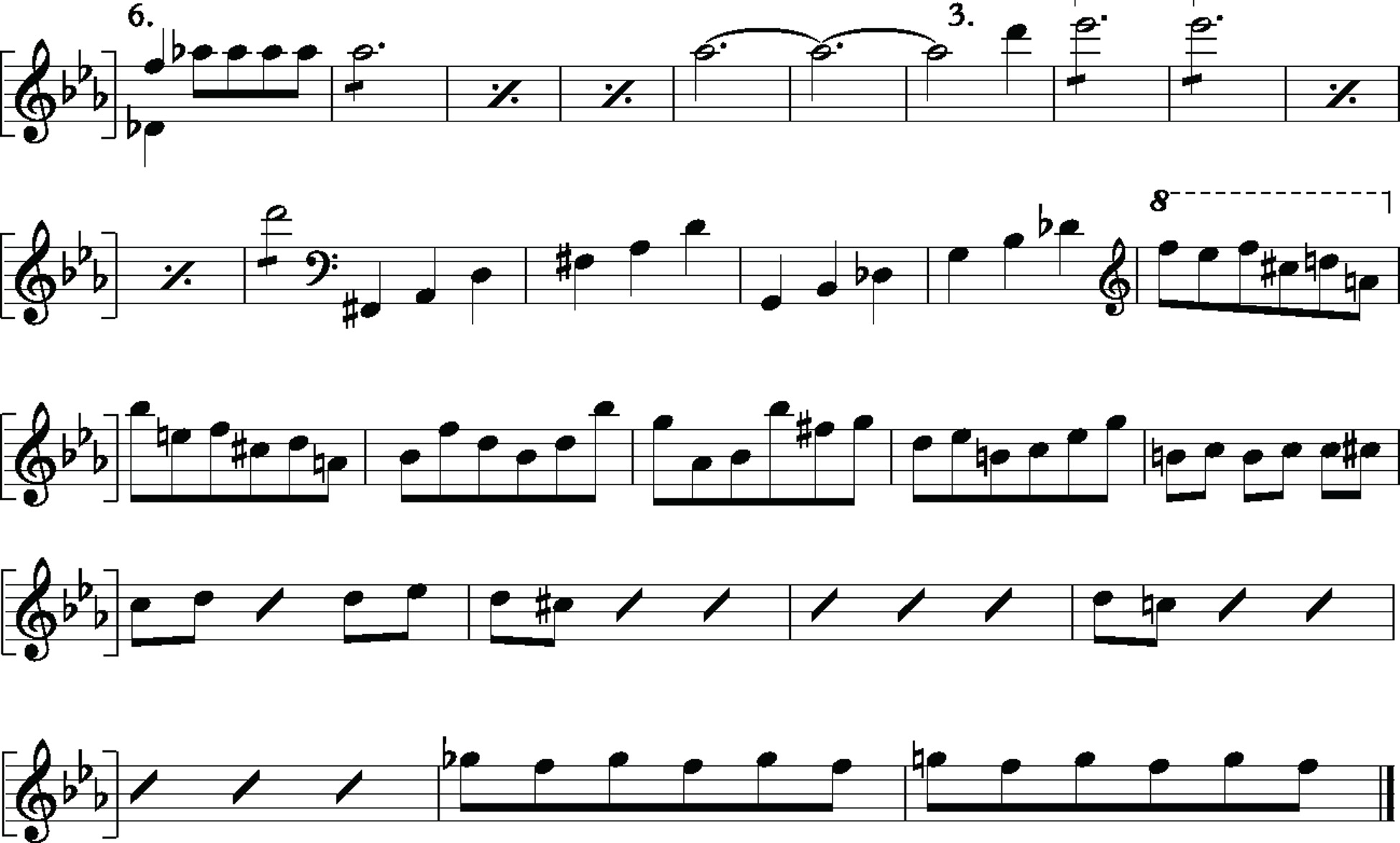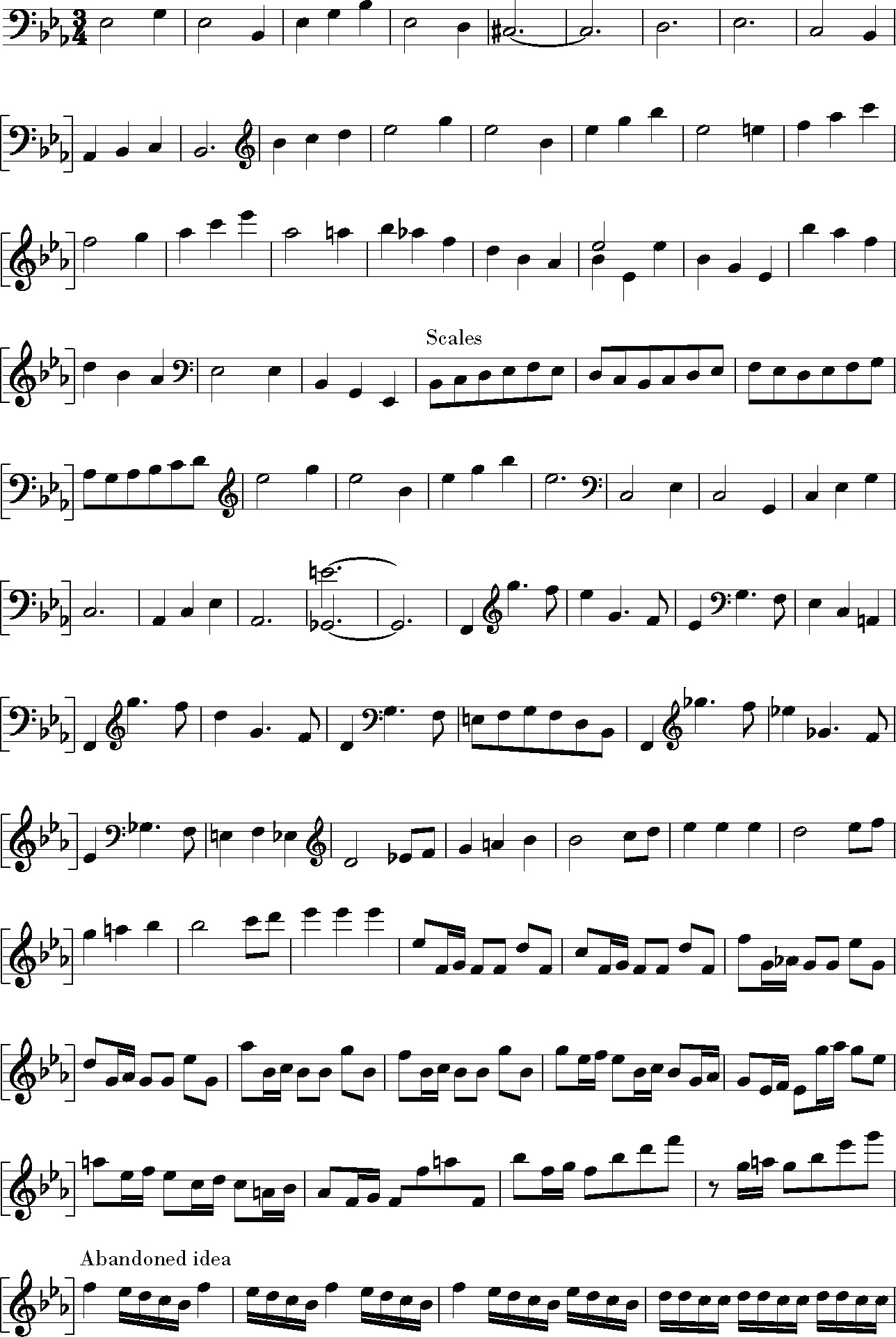Beethoven: Anguish and Triumph (55 page)
The way he does that is to base the beginning on the ending. A work feeds on itself. To get to the next step, you stand on what you have. So he derives his first-movement
Thema
from the last-movement
Prometheus
ideas. This is no great trick, a familiar process for him: taking a piece of material and making something new out of it. Once he has his opening
Thema
he can compose forward, working out the finale in detail at the end of the process.
To do that, he has to consider,
What sort of
Thema
for the beginning?
In the sketch with ideas for the first three movements that he jotted down in summer 1802, he makes what appear to be two attempts to fashion a new theme out of the bass:
14
Â

Beethoven: Studies in the Creative Process
Â
With these perhaps first attempts to turn the end into a beginning, he has already come to a surprising decision about the first movement. This evocation of a military hero, of campaigns and battles, will be in 3/4 time rather than in the 2/4 or 4/4 march time of military music. The music of the opening movement will have no literal evocation of marches or pageantry at all. It will be in a meter and in a lilting triple rhythm suggesting a danceâsay, a waltzârather than the military tread that marks the openings of his concertos. The symphony's first movement is to be a kind of abstraction of heroism in the meter and rhythm of dance: a dance of destruction and creation in 3/4 time.
To make his
Thema
he squeezes the
Prometheus
scraps for everything they hold. Since for Beethoven what comes first is usually most important, the first four notes of the
basso
are the prime issue: the move from tonic to dominant and back, the octave outline of the two B-flats. The rising chromatic slide in the middle of the
basso
will also serve.
Finally, to make the opening theme he adds the note G to the scaffolding of the
basso
and inverts the direction of the two B-flats. To that he appends the three-note chromatic slide, this time going not up but down: E-flatâDâC-sharp. The first three notes of the resulting
Thema
, a major third up and back down, E-flatâGâE-flat, are the same as the first three notes of the
englische
tune. The new theme and the
englische
share a trochaic rhythm, longâshort, longâshort, and a wavelike shape:
Â

Â
In other words, the new opening starts by outlining an E-flat-major chord, a triad, filling in the outline of the bass theme and forming the familiar figure of a horn call. A triadic horn call, then, is the essence of
das Thema
. Taking the most common chord in music as the leading motif is an utterly Beethovenian way to proceed. Surely from Haydn he had learned that he could start with something nearly meaningless and fill it with meaning through the course of a work.
At some point before summer 1803, he has fashioned that triadic opening
Thema
. When he has settled on his theme, in a new sketchbook he begins to shape all the themes of the movement on or around a triad. As it turns out, his leading idea is not really a theme in the usual sense but simply a triad followed by a chromatic figure. Those motifs will turn up separately and together in evolving forms and permutations.
While Beethoven improvises at the keyboardâand scribbles and walks, howls, conducts, stamps his feet and pounds the tableâtechnique, story, symbol, and expression take shape together. Call the symphony's opening theme “the Hero.” It is hardly a melody, less a theme in the usual sense than (like the
basso
) a kind of primal gesture. And this protean scrap of material has not just an abstract but a symbolic dimension: in the same way that the Hero theme generates the subsidiary themes of the first movement, the spirit of the Hero imbues his soldiers and his campaigns.
15
Â
With his
Thema
in hand, Beethoven can go forward from the opening movement's first part to
Durchführung
to da capo and codaâin the terms of a later time, exposition, development, recapitulation, coda. Amid the ragged tumult of ideas spilling into the sketchbook, he begins to make longer continuity drafts of the exposition. As in all his sketches, a single line of melody or figuration stands in for the full ensemble he hears in his mind.
Feeling his way into the exposition section, he is already working with quite particular concepts. The first continuity sketch looks like this:
Â

Â
Â

Two Beethoven Sketchbooks
Â
Much of that sketch will fall by the wayside, but already it has elements that will endure: (1) an opening on two monumental chords slashed onto silence, similar to the beginning of the
Prometheus
Overture (but not the same chords or the two downbeats he finally settles on); (2) the Hero theme fully formed in its dancelike 3/4, with a chromatic slide down to an out-of-key C-sharp that throws the harmony into uncertainty;
16
(3) several variants of that chromatic slide; (4) a flowing second theme in B-flat built on the triadic motif of the Hero theme; (5)Â a skittering theme built on a descending triad (the theme will remain, but the harmony will change); and (6) a modulation to the distant key of D-flat, an enharmonic echo of the C-sharp in measure 7 (but the key of D-flat not in its final position in the movement). This continuity sketch spawns variants of some of its segments, some of those side sketches representing discoveries, some of them dead ends.
In this first attempt at the exposition, he is already creating a sense of restless flux: in the middle of the first continuity sketch (marked X), the Hero theme climbs stepwise through a row of keys, B-flat to C to D-flat to E-flat. He will end up placing that idea later, in the development. Already, subsidiary themes are proliferating beyond the conventional one or two or three.
In an addendum to the first continuity sketch, he arrives at another significant idea, another resonance that will start on the first pages: the idea of drifting. The quiet first statement of the Hero theme drifts off into uncertainty (the C-sharp) before righting itself back in E-flat. The second statement of the theme starting in the solo horn drifts, with an upward chromatic slide, into F minor in the violins. Eventually the third statement of the theme will be a
fortissimo
eruption in E-flat for full orchestraâwhich quickly drifts into
piano
. No point of arrival holds steady. Already, this drifting conjures the image of a protagonist in motion, advancing but not yet arriving.
In another sketch he finds the hemiola figure that will be a steady feature of the movement: superimposing two-beat patterns over the three-beat meter, generating energy by striding across the bar line.
17
In a further sketch, Beethoven discovers another idea for the first page that will have great import: the unsettling syncopations of the violins moving from G to A-flat and back. That pair of notes will have a long career in the symphony.
Already, then, he has one of the central conceptions: he wants his exposition restless and searching, so its themes need to be fragmentary, incomplete, constantly in flux. From the first airing of the Hero theme forward, each idea will start decisively and then drift, avoiding a sense of closure or clear formal articulation. Everything points forward rather than feeling like an arrival. He wants that incessant nervous energy as an evocation of a military campaign or a battle: great forces on the move not only across a landscape but across the mind and across history. At the head of those forces, their driving energy: the Hero.
Which is all to say that
he fashions the exposition
as if it were a development
.
18
This will be music about a process of
becoming
. Here is another element both abstract and symbolic: the Hero striving
toward
something. Call it
victory;
call it
coming into his own
.
19
In the sketchbook, the second extended concept sketch is longer, a try at the whole exposition. Now he is up to five themes and has realized that if he wants that many ideas in an exposition, he needs to give each of them a distinctive character, rhythmic profile, and orchestral color. Eventually, there will be effectively six themes in the exposition, all of them less themes in the usual sense than protean gestures. The second concept sketch:
Â

Two Beethoven Sketchbooks
Â
He will throw out the last of those themes as irrelevant. In this continuity sketch also appears a hint of the loping scale figures he will use to link sections. And generally, from here on, each theme will be characterized not only by a distinctive rhythm but also by the way it interacts with or against the meter. Most of the themes (except, significantly, the Hero theme) break free of the bar line in one way and another.
